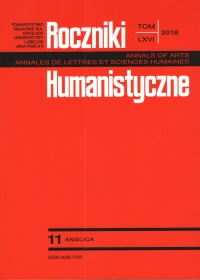Being John Malkovich and the Philosophy of Cyberspace Addiction
Abstrakt
Być jak John Malkovich i filozofia uzależnienia od cyberprzestrzeni
Niniejszy artykuł omawia możliwy przykład symbolicznej interakcji cyberprzestrzeni z przestrzenią rzeczywistą. Jego tematem jest analiza fabuły filmu Spike’a Jonze’a Być jak John Malkovich (oryg. Being John Malkovich) z 1999 roku, a przedstawiona teza dotyczy możliwości interpretacji filmu jako filozoficznej alegorii uzależnienia od cyberprzestrzeni. Analiza filmu skupia się na jego głównych bohaterach oraz różnych formach ich relacji z tytułowym Johnem Malkovichem, który stanowi w filmie uosobienie cyberprzestrzeni.
Bibliografia
Adair, Gilbert. 2000. “Malkovich through His Own Eyes.” The Independent, 19 March 2000. Accessed 6 March 2018. http://www.independent.co.uk/arts-entertainment/films/reviews/malkovich-through-his- own-eyes-257904.html.
“Being John Malkovich.” Metacritic. Accessed 6 Mar. 2018. http://www.metacritic.com/movie/being-john-malkovich.
“Being John Malkovich—Rotten Tomatoes Review.” Rotten Tomatoes. Accessed 6 March 2018. https://www.rottentomatoes.com/m/being_john_malkovich/.
Bell, David. 2004. Cyberculture the Key Concepts. New York, Routledge.
Coplan, Amy. 2008. “Empathy and Character Engagement.” In The Routledge Companion to Philosophy and Film, edited by Paisley Livingston and Carl Plantinga. London, New York: Routledge.
Ebert, Roger. 1999. “Being John Malkovich Movie Review (1999).” Roger Ebert. Accessed 13 March 2018. https://www.rogerebert.com/reviews/being-john-malkovich-1999.
Gaut, Berys. 2010. A Philosophy of Cinematic Art. Cambridge: Cambridge University Press.
Gibson, William. 2000. Neuromancer. New York: Ace Books.
Jenkins, Henry. 2006. “Game Design as Narrative Architecture.” In First Person New Media as Story, Performance, and Game, edited by Noah Wardrip-Fruin and Pat Harrigan. Cambridge, MA, London: MIT Press.
Klimmt, Christoph, Dorothée Hefner, and Peter Vorderer. 2009. “The Video Game Experience as ‘True’ Identification: A Theory of Enjoyable Alterations of Players’ Self-Perception.” Communication Theory 19 (4): 351–373. https://doi.org/10.1111/j.1468-2885.2009.01347.x
Klimmt, Christoph, Dorothée Hefner, and Peter Vorderer. 2010. “Identification With Video Game Characters as Automatic Shift of Self-Perceptions.” Media Psychology 13 (4): 323–338. https://doi.org/10.1080/15213269.2010.524911.
Rooney, David. 1999. “Being John Malkovich.” Variety, 3 September 1999. http://variety.com/1999/ film/reviews/being-john-malkovich-1117752080/.
Van Cleave, Ryan G. 2010. Unplugged: My Journey into the Dark World of Video Game Addiction. Deerfield Beach: Health Communications.
Weinstein, Lissa, and Banu Seckin. 2008. “The Perverse Cosmos of Being John Malkovich: Forms and Transformations of Narcissism in a Celebrity Culture.” Projections 2 (1): 27–44. https://doi.org/10.3167/proj.2008.020103.
Copyright (c) 2018 Roczniki Humanistyczne

Utwór dostępny jest na licencji Creative Commons Uznanie autorstwa – Użycie niekomercyjne – Bez utworów zależnych 4.0 Międzynarodowe.





